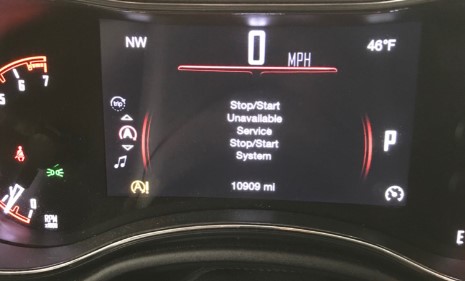Does your car’s stop-start system keep throwing up a warning light? Don’t despair! We’ve got you covered with this in-depth guide to troubleshooting and fixing the issue. From understanding the system to identifying common faults and finding the right solution, we’ll equip you with the knowledge to get your car running smoothly again.

Image: www.actonservicecentre.co.uk
Understanding the Stop-Start System
Stop-start technology automatically turns off the engine when the car comes to a standstill, such as at traffic lights or in slow-moving traffic. This clever system saves fuel and reduces emissions by eliminating unnecessary idling. When you press the brake pedal, the engine seamlessly restarts, allowing you to drive off effortlessly.
Common Causes of Stop-Start Warning Lights
If you’re seeing that dreaded stop-start warning light, here are some potential culprits:
- Low battery: The stop-start system requires a lot of battery power. If your battery is starting to get old or weak, it may not be able to provide sufficient power to operate the system.
- Electrical faults: Issues with wiring, sensors, or other electrical components can cause the stop-start system to malfunction.
- Alternator problems: The alternator recharges the battery while you drive. If the alternator is not working properly, it may not be able to keep up with the power demands of the stop-start system.
- Transmission issues: The transmission needs to be in neutral or park for the stop-start system to engage. If there are problems with the transmission, the system may not work properly.
- Faulty sensors: Sensors detect when the brake pedal is pressed and when the vehicle is stationary. If these sensors are faulty, the stop-start system may not engage or may shut off the engine prematurely.
Fixing the Stop-Start Warning Light
Depending on the underlying cause, there are various ways to fix the stop-start warning light issue:
- Check the battery: Test your battery with a multimeter to verify its voltage and health. If the battery is weak, replace it with a new one.
- Inspect electrical components: Examine wires, fuses, and connectors for loose connections, damage, or corrosion. Repair or replace any faulty components as necessary.
- Test the alternator: Use a voltmeter to check if the alternator is outputting the correct voltage. If the alternator is faulty, replace it.
- Diagnose transmission issues: Have a qualified mechanic inspect the transmission and identify any underlying problems.
- Check the sensors: Test the brake pedal sensor and the neutral position sensor to ensure they’re functioning properly. Replace any defective sensors.

Image: warninglights.net
Additional Troubleshooting Tips
Before embarking on any repairs, try these simple steps:
- Restart the car: Sometimes, a simple restart can reset computer systems and fix minor glitches.
- Check the vehicle’s manual: Refer to your car’s owner’s manual for specific troubleshooting advice and any cautionary notes related to the stop-start system.
- Allow the system to cool down: If the stop-start system has been working overtime in heavy traffic, it may temporarily shut off as a protective measure. Let the car rest for a while to allow the system to cool down.
- Use a diagnostic scanner: For more complex issues, a diagnostic scanner can provide specific error codes that indicate the exact cause of the stop-start system malfunction.
How To Fix Stop Start Warning Light
Conclusion
Fixing a stop-start warning light can be a straightforward process with the right knowledge and troubleshooting techniques. By understanding the stop-start system, identifying common faults, and implementing the appropriate solutions, you can get your car’s engine running smoothly and efficiently again. Don’t hesitate to seek professional help if necessary, and always refer to your vehicle’s owner’s manual for specific instructions and safety precautions.